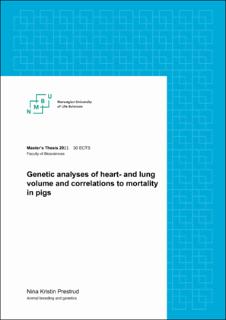| dc.description.abstract | The occurrence of sudden cardiac death in pigs (Sus scrofa domestica) is a known problem. Sudden death of pigs causes economic consequences for the farmers and is a challenge for animal welfare. Compared to the wild boar, which is the ancestor of the domestic pig, the size of the heart of the domestic pig has decreased in relation to body weight. It is conceivable that this causes an insufficiency of the cardiovascular system. As the heart size has decreased, it is also conceivable that the size of the lungs, which is located in the thoracic cavity together with the heart, has decreased as well. A decreased lung size could affect the oxygen supply. This will most likely not benefit an already insufficient cardiovascular system. Hypertrophic cardiomyopathy (HCM) is a heritable condition defined by the presence of an increased left ventricular thickness and can cause sudden cardiac death. If HCM occurs in pigs and this condition is aggravated by an insufficiency of the cardiovascular- and respiratory system, it would be in interest to find out if heart- and lung volume are traits possible to breed for. The aim of this thesis is therefore 1) To estimate genetic parameters for heart- and lung volume in pigs and the genetic trend for these. 2) To determine if there is a genetic correlation between heart- and lung volume and mortality in pigs.
The data used in this thesis was obtained by Norsvin and Topigs Norsvin and consists of data of heart- and lung volumes of 5 430 and 5 464 purebred Landrace and Duroc boars, and data of mortality of 202 233 and 6 812 purebred individuals of Landrace and Duroc. The data of heart- and lung volume was obtained by CT-images of the boars. The data of mortality are registrations of individuals who have died by themselves in the period from weaning to finishing. Genetic parameters and genetic correlations were calculated for heart volume, lung volume and mortality. Genetic trends were investigated for heart- and lung volume.
Heritabilities ranging from 0,313 – 0,402 was found for heart- and lung volume for both breeds. There was a positive genetic correlation between heart- and lung volume for Duroc. A small positive genetic correlation was found between heart volume and mortality for Landrace. Mortality was not analysed for Duroc because of a too small dataset. A decreasing genetic trend for heart- and lung volume was found for both breeds. To conclude: there is a genetic variation in heart- and lung volume for both the breeds and the genetic trend for these traits should therefore be possible to change by selection. It is conceivable that heart and lung volume for Duroc, to some extent, changes together. The positive correlation between heart volume and mortality for Landrace indicates that relatives of pigs with genetically bigger hearts at CT-scanning tends to have higher mortality. Further research should be conducted. | en_US |

